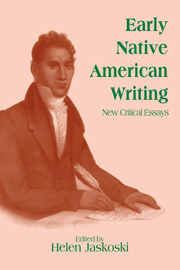Book contents
- Frontmatter
- Contents
- Foreword
- Preface
- List of Contributors
- 1 “Honoratissimi benefactores” Native American students and two seventeenth-century texts in the university tradition
- 2 “Pray Sir, consider a little”: Rituals of subordination and strategies of resistance in the letters of Hezekiah Calvin and David Fowler to Eleazar Wheelock
- 3 “(I speak like a fool but I am constrained)”: Samson Occom's Short Narrative and economies of the racial self
- 4 “Where, then, shall we place the hero of the wilderness?”: William Apess's Eulogy on King Philip and doctrines of racial destiny
- 5 “They ought to enjoy the home of their fathers”: The treaty of 1838, Seneca intellectuals, and literary genesis
- 6 “I am Joaquin!”: Space and freedom in Yellow Bird's The Life and Adventures of Joaquin Murieta, the Celebrated California Bandit
- 7 “This voluminous unwritten book of ours”: Early Native American writers and the oral tradition
- 8 “A terrible sickness among them”: Smallpox and stories of the frontier
- 9 “A desirable citizen, a practical business man”: G. W. Grayson – Creek mixed blood, nationalist, and autobiographer
- 10 “An Indian … An American”: Ethnicity, assimilation, and balance in Charles Eastman's From the Deep Woods to Civilization
- 11 “Overcoming all obstacles”: The assimilation debate in Native American women's journalism of the Dawes era
- 12 “My people … my kind”: Mourning Dove's Cogewea, The Half-Blood as a narrative of mixed descent
- 13 “Because I understand the storytelling art”: The evolution of D'Arcy McNickle's The Surrounded
9 - “A desirable citizen, a practical business man”: G. W. Grayson – Creek mixed blood, nationalist, and autobiographer
Published online by Cambridge University Press: 20 February 2010
- Frontmatter
- Contents
- Foreword
- Preface
- List of Contributors
- 1 “Honoratissimi benefactores” Native American students and two seventeenth-century texts in the university tradition
- 2 “Pray Sir, consider a little”: Rituals of subordination and strategies of resistance in the letters of Hezekiah Calvin and David Fowler to Eleazar Wheelock
- 3 “(I speak like a fool but I am constrained)”: Samson Occom's Short Narrative and economies of the racial self
- 4 “Where, then, shall we place the hero of the wilderness?”: William Apess's Eulogy on King Philip and doctrines of racial destiny
- 5 “They ought to enjoy the home of their fathers”: The treaty of 1838, Seneca intellectuals, and literary genesis
- 6 “I am Joaquin!”: Space and freedom in Yellow Bird's The Life and Adventures of Joaquin Murieta, the Celebrated California Bandit
- 7 “This voluminous unwritten book of ours”: Early Native American writers and the oral tradition
- 8 “A terrible sickness among them”: Smallpox and stories of the frontier
- 9 “A desirable citizen, a practical business man”: G. W. Grayson – Creek mixed blood, nationalist, and autobiographer
- 10 “An Indian … An American”: Ethnicity, assimilation, and balance in Charles Eastman's From the Deep Woods to Civilization
- 11 “Overcoming all obstacles”: The assimilation debate in Native American women's journalism of the Dawes era
- 12 “My people … my kind”: Mourning Dove's Cogewea, The Half-Blood as a narrative of mixed descent
- 13 “Because I understand the storytelling art”: The evolution of D'Arcy McNickle's The Surrounded
Summary
In the development of American Indian autobiography the first two decades of the twentieth century were a turning point. In 1902 Charles Eastman published Indian Boyhood, his story of growing up in what he claimed was the vanished traditional world of the Santee Sioux. In 1906 S. M. Barrett published Geronimo's Story of His Life, the last or nearly the last of the popular dictated autobiographies of famous war chiefs. And in 1920 Paul Radin published the first autobiography written at the request of an anthropologist, The Autobiography of a Winnebago Indian. In between, Eastman published his second volume, From the Deep Woods to Civilization (1916), telling of his assimilation into the white world; the Dutch businessmanethnologist William Wildschut began his interviews with Two Leggings, which would be the basis of Peter Nabokov's later volume, and various memorialists like Joseph Dixon published collections of autobiographies which were intended to be records of the end of the noble redman (The Vanishing Race, 1913).
This was, therefore, a period of significant endings and beginnings: the end of autobiographies of war chiefs dictated to journalists, the beginning of lives of supposedly ordinary or representative Indians written for anthropologists, and many stories of the “end” of traditional practices and “beginning” of new ones along “the white man's path” (as Eastman called it). Moreover, these stories coincided, as David Brumble has pointed out, with the triumph of social Darwinism as a national ideology and the implementation of the Dawes Act (148–55).
- Type
- Chapter
- Information
- Early Native American WritingNew Critical Essays, pp. 158 - 172Publisher: Cambridge University PressPrint publication year: 1996



